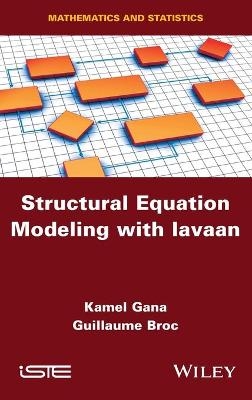
Structural Equation Modeling with lavaan
ISTE Ltd and John Wiley & Sons Inc (Verlag)
978-1-78630-369-1 (ISBN)
Structural Equation Modeling with lavaan thus helps the reader to gain autonomy in the use of SEM to test path models and dyadic models, perform confirmatory factor analyses and estimate more complex models such as general structural models with latent variables and latent growth models.
SEM is approached both from the point of view of its process (i.e. the different stages of its use) and from the point of view of its product (i.e. the results it generates and their reading).
Kamel Gana is Professor of Health Psychology at the University of Bordeaux, France. He has been teaching introductory workshops on SEM in various universities for 15 years. Guillaume Broc, a Doctor in Psychology, is currently a Postdoctoral Fellow at Claude Bernard University Lyon 1, France. He is a specialist in health psychology and is interested in quantitative and qualitative data analysis.
Preface ix
Introduction xi
Chapter 1 Structural Equation Modeling 1
1.1 Basic concepts 2
1.1.1 Covariance and bivariate correlation 2
1.1.2 Partial correlation 5
1.1.3 Linear regression analysis 7
1.1.4 Standard error of the estimate 10
1.1.5 Factor analysis 11
1.1.6 Data distribution normality 18
1.2 Basic principles of SEM 21
1.2.1 Estimation methods (estimators) 27
1.3 Model evaluation of the solution of the estimated model 36
1.3.1 Overall goodness-of-fit indices 36
1.3.2 Local fit indices (parameter estimates) 43
1.3.3 Modification indices 44
1.4 Confirmatory approach in SEM 45
1.5 Basic conventions of SEM 47
1.6 Place and status of variables in a hypothetical model 49
1.7 Conclusion 49
1.8 Further reading 50
Chapter 2 Structural Equation Modeling Software 53
2.1 R environment 54
2.1.1 Installing R software 55
2.1.2 R console 55
2.2 lavaan 58
2.2.1 Installing the lavaan package 58
2.2.2 Launching lavaan 58
2.3 Preparing and importing a dataset 60
2.3.1 Entry and import of raw data 60
2.3.2 What to do in the absence of raw data? 63
2.4 Major operators of lavaan syntax 65
2.5 Main steps in using lavaan 66
2.6 lavaan fitting functions 68
Chapter 3 Steps in Structural Equation Modeling 69
3.1 The theoretical model and its conceptual specification 70
3.2 Model parameters and model identification 71
3.3 Models with observed variables (path models) 73
3.3.1 Identification of a path model 74
3.3.2 Model specification using lavaan (step 2) 76
3.3.3 Direct and indirect effects 78
3.3.4 The statistical significance of indirect effects 80
3.3.5 Model estimation with lavaan (step 3) 81
3.3.6 Model evaluation (step 4) 82
3.3.7 Recursive and non-recursive models 83
3.3.8 Illustration of a path analysis model 85
3.4 Actor-partner interdependence model 90
3.4.1 Specifying and estimating an APIM with lavaan 92
3.4.2 Evaluation of the solution 93
3.4.3 Evaluating the APIM re-specified with equality constraints 94
3.5 Models with latent variables (measurement models and structural models) 95
3.5.1 The measurement model or Confirmatory Factor Analysis 97
3.6 Hybrid models 148
3.7 Measure with a single-item indicator 149
3.8 General structural model including single-item latent variables with a single indicator 151
3.9 Conclusion 152
3.10 Further reading 155
Chapter 4 Advanced Topics: Principles and Applications 157
4.1 Multigroup analysis 157
4.1.1 The steps of MG-CFA 162
4.1.2 Model solutions and model comparison tests 166
4.1.3 Total invariance versus partial invariance 171
4.1.4 Specification of a partial invariance in lavaan syntax 172
4.2 Latent trait-state models 172
4.2.1 The STARTS model 173
4.2.2 The Trait-State-Occasion Model 197
4.2.3 Concluding remarks 211
4.3 Latent growth models 213
4.3.1 General overview 213
4.3.2 Illustration of an univariate linear growth model 223
4.3.3 Illustration of an univariate non-linear (quadratic) latent growth model 228
4.3.4 Conditional latent growth model 232
4.3.5 Second-order latent growth model 240
4.4 Further reading 249
References 251
Index 269
| Erscheinungsdatum | 12.02.2019 |
|---|---|
| Verlagsort | London |
| Sprache | englisch |
| Maße | 160 x 236 mm |
| Gewicht | 612 g |
| Themenwelt | Mathematik / Informatik ► Mathematik ► Angewandte Mathematik |
| Mathematik / Informatik ► Mathematik ► Computerprogramme / Computeralgebra | |
| Technik ► Bauwesen | |
| Technik ► Maschinenbau | |
| ISBN-10 | 1-78630-369-8 / 1786303698 |
| ISBN-13 | 978-1-78630-369-1 / 9781786303691 |
| Zustand | Neuware |
| Informationen gemäß Produktsicherheitsverordnung (GPSR) | |
| Haben Sie eine Frage zum Produkt? |
aus dem Bereich


